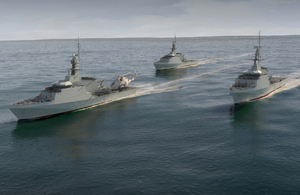Royal Navy prepares for future UK fishery patrols
The Royal Navy has taken delivery of the first of their next-generation Offshore Patrol ships which will support monitoring and protection of UK fisheries after we leave the EU.

HMS Forth is the first of five Batch 2 River Class Offshore Patrol Vessels
HMS Forth is the first of five state-of-the-art Royal Navy vessels designed for fishery protection, as well as counter-piracy, anti-smuggling, border patrol, counter terrorism and maritime defence duties.
Defence Secretary Gavin Williamson said:
The Royal Navy has a proud tradition of protecting the UK’s coastline and keeping a close eye on our fishing waters. With these state-of-the-art, vastly capable ships we stand ready to protect our fisheries once Britain leaves the EU.
The River-class Offshore Patrol Vessels (OPV) ‘production line’ is moving apace with the £116 million ships emerging at around six month intervals. The Royal Navy Fishery Protection Squadron are expecting a further two ships – HMS Medway and Trent – to be handed over later this year, with the remaining two – HMS Tamar and Spey – expected to arrive in Portsmouth by 2020. Just last week HMS Trent was formally named at the Glasgow shipyard where was built.
They will become the Royal Navy’s eyes and ears around the UK, helping to safeguard fishing stocks. They will also assist in reassuring and protecting the Falkland Islands and are capable of deploying to the Mediterranean and Caribbean to uphold UK interests around the world.
Last week the Treasury announced that the MOD will receive £12.7 million from the Government’s Brexit preparation allocation to support work with DEFRA on maintaining the UK’s fisheries. The MOD is working closely with other government departments like DEFRA to determine the optimum deployment of these extremely flexible vessels.
With a total crew of around 58, but designed to go to sea with 39, they can spend up to 320 days a year on operational taskings. The larger crew allows a rotation of personnel to ensure they get to spend time at home or on training.
The new OPVs are four knots faster than their predecessors at 24 knots, have an increased range of 5,500 nautical miles, have a 30mm automatic cannon as their main armament instead of a 20mm gun, two Miniguns, four machine-guns and are equipped with two Pacific 24 sea boats. Each ship has an extended flight deck to operate up to Merlin size helicopters and accommodation for up to 50 embarked Royal Marines for boarding and supporting operations ashore if required.